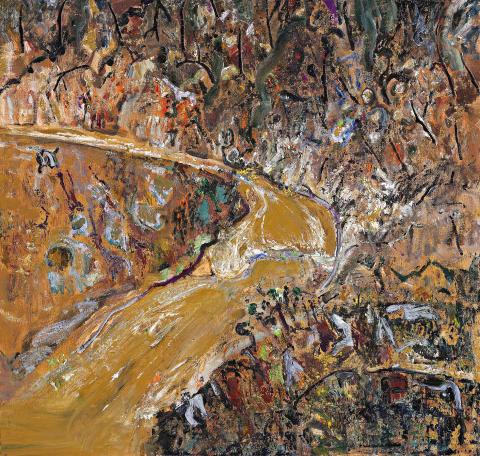FLOODED CREEK, 1977
FRED WILLIAMS
oil on canvas
101.5 x 107.0 cm
signed lower right: Fred Williams.
Private collection
Sotheby's, Melbourne, 19 April 1993, lot 310
Private collection, Melbourne
Private collection, Queensland
National Travelling Exhibition: Fred Williams – paintings, gouaches, lithographs (Adelaide Festival Exhibition), Contemporary Art Society of Australia (SA) Inc., Adelaide, 16 March – 6 April 1978, cat. 41
Werribee Gorge, 1976, oil on canvas, 183.0 x 110.5 cm, illus. in McCaughey, P., Fred Williams, Bay Books, Sydney, 1980, p. 294
Dry Creek Bed, Werribee Gorge I 1977, oil on canvas, 183.0 x 152.5 cm, National Gallery of Australia, Canberra
Dry Creek Bed, 1976, oil on canvas, 183.0 x 152.5 cm, collection of Kahlbetzer, J., illus. in McCaughey, P., Fred Williams, Bay Books, Sydney, 1980, p. 296
By the late 1960s, Fred Williams’ paintings of the Australian landscape had become so sparse, lean and devoid of colour that they were almost minimalist abstractions. In 1971 he visited Albert Tucker at his property in Queensland and at his host’s suggestion, experimented with synthetic polymer paints triggering a suite of paintings full of unexpected verve and colour (James Mollison notes that the arrival of colour television in Australia was also an impetus).1 Although he soon discarded the industrial product, the experience unleashed what can only be considered as a second flowering in Williams’ career, with an incredible range of images bursting with richly hued vitality.
On his return, Williams, who had never learned to drive a car, initiated a weekly ritual whereby a fellow artist (first John Perceval, then Fraser Fair) would pick him up on a Wednesday and travel to the bush before setting up their easels ‘rain, sun or cold … (painting) feverishly for six hours.’2 The canvases would then be reworked wet-on-wet in the studio the following day. Although the locations were often non-heroic, Williams became attracted to gorges and waterfalls, ‘increasingly drawn to an elemental landscape where forces, which shaped the land, could be observed and painted.’3
Painted near the end of the ‘Gorge’ cycle, Flooded Creek, 1977 is a vivid response to the raging torrent of water engorged by recent rains. The sharp 90º bend provides a restless visual trajectory through the painting and also features in related works such as Chalk Creek, 1977 (Art Gallery of Western Australia, Perth), and Dry Creek Bed, Werribee Gorge I, 1977 (Tate Gallery, London). Using the bristles and end of his brush, the surface is further animated by Williams’ use of ‘tonking’, a method of removing excess oil from the canvas by blotting with scrunched absorbent paper, particularly effective when articulating the scrubby nature of the Australian bush.4 Williams was once quoted as saying he didn’t like the Australian bush and the constant repetition of this contradictory statement in articles on the artist caused his wife Lyn to compose a firm rebuttal, stating ‘(c)ertainly he did not like the bush the way a 19th Century Banjo Paterson-man liked it, because he was a 20th century city-bred person, as 90% of us are. He was not involved with the romantic myths of our bush-bred past but about how he perceived it today. …. He tried to maintain his objectivity, but as one of our daughters said, you only have to look at his paintings to know whether he cared about the landscape.’5
Flooded Creek was painted in the same year that Fred Williams became the first Australian artist to have a solo exhibition at the prestigious Museum of Modern Art in New York.6
1. Mollison, J., ‘Williams, Frederick Ronald (Fred) (1927–1982)’, Australian Dictionary of Biography, Volume 18, Melbourne University Press, Melbourne, 2012
2. McGrath, S., ‘Williams just can’t relax’, The Australian, Canberra, 6 May 1978
3. McCaughey, P., The Later Landscapes of Fred Williams, La Louver, California, 2005, p. 11
4. Named after the British artist Henry Tonks (1862–1937) and still taught in London art schools when Williams studied there in the early 1950s.
5. Lyn Williams, letter to the Editor, The National Times, Canberra, 9–15 May 1982, p. 33
6. Fred Williams: landscapes of a continent, Museum of Modern Art, New York, 11 March – 8 May 1977. The exhibition of 40 gouaches was a complete sell-out.
ANDREW GAYNOR
